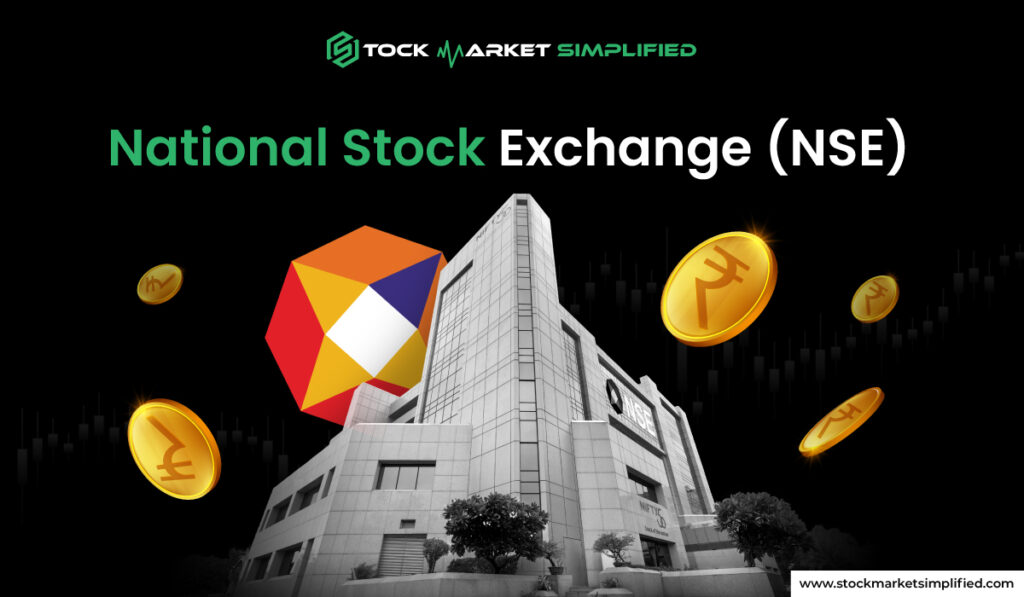National Stock Exchange(NSE)

Overview
Stock market is a tempting space with a growing number of investors. Sidhartha Bhaiya, a Mumbai-based money manager, aptly describes NSE as “India’s Las Vegas,”. The reference highlights the alarming need for stock market knowledge before investing.
For the common investor navigating the stock market, the choice between BSE and NSE often comes down to a subtle difference in prices. However, only few take the plunge to dig the depths of information about NSE and BSE. If you are here to ask about the basics of NSE, congratulations! you have stepped out of the crowd – toward your financial empowerment journey. This journey is not a sprint; it’s a marathon,
– but it’s worth every second you invest in. Here let’s discuss what NSE is, how it works, its functions, and benefits in a simplified way.
What is NSE (National Stock Exchange)?

Established in 1992, NSE or the National Stock Exchange is India’s largest financial market. It is a platform where investors can buy and sell their securities and other financial instruments. Introduced to make the Indian equity market transparent and reliable, it was also the first exchange to offer paperless trading and investment facilities in India. The segments of NSE includes:
- Equity
- Indices
- Mutual Funds
- ETFs or Exchange Traded Funds
- IPOs
- Borrowing and Lending of Securities
- Equity Derivatives
- Commodity Derivatives
- Currency Derivatives
- Interest Rate Futures
- Corporate Bonds, etc.
Being the youngest stock exchange in India, NSE has grown into an advanced electronic market. It has been ranked as the fourth world’s largest exchange in terms of equity trading volume. NSE was India’s first transparent, modern and fully automated platform. As per market capitalisation, the top ten stocks on NSE include HDFC bank, ICICI bank, TCS, Reliance Industries, Infosys, HUL, etc.
How Does NSE Work?

NSE executes trades using an advanced “electronic limit order book” system named NEAT (National Exchange for Automated Trading). This means, when an investor places a buy or sell order, the automated electronic system efficiently matches with the limit order, ensuring seamless execution at the earliest possible. Hence, there is no need left for market makers or specialists. Sellers and buyers also gain the benefit of remaining anonymous.
Regulatory Guardian: SEBI Oversight
SEBI (The Securities and Exchange Board of India) heads the regulatory administration of the NSE. The organization makes sure that all the stock exchanges comply with the necessary regulations which protect the interest of investors and the integrity of the market. SEBI’s watchful eye contributes to fostering a fair and transparent trading environment.
NSE’s Transparency Mission
The primary purpose behind establishing NSE was to ensure more transparency to investors in regards to exchanges happening on the trading system. The entity allows investors to place orders seamlessly, ensuring clear and open exchanges. Investors can place their orders using stockbrokers, who offer online trading facilities to users for quicker and easier trade.
Functions of NSE

NSE plays a pivotal role in maintaining transparency and safeguarding investors’ rights by providing a trading platform that is not only convenient and decent but also transparent. Here are some of the key functions of NSE that you need to know:
- To provide a convenient trading facility to investors across the nations, integrating equity, debt, and other asset categories.
- To provide equal opportunities and information to all interested investors
- To facilitate a trading platform that meets parameters of the global exchange markets
- To implement the book-entry settlement system
- To reduce time duration of trade settlement
- To verify and permit the listing of overseas companies, IPOs (initial public offerings), and Indian Depository Receipts (IDRs), debt issues
- To ensure a transparent, fair, and efficient securities market for investors using electronic trading systems
With technological advancement, NSE has significantly updated its technology, now hold the capability of executing over 1.6 lakh requests or orders per second.
Major Indices in National Stock Exchange

NSE introduced its primary benchmark indices, NIFTY 50, in 1994. It includes the top 50 stocks that are most actively traded on the NSE, which includes 63% of capitalisation of the NSE. The index includes 12 different segments of the economy under 50 variable stocks. Despite this, there are several other indices listed on NSE such as:
- Nifty 100 Index
- Nifty Bank
- Nifty Midcap 100
- Nifty Next 50 index
- Nifty 50 Midcap index
- Nifty Small cap 250 index
- India Vix index
It also includes other indices under strategy, thematic, hybrid, and fixed income.
Benefits of NSE

Among the transformation that NSE has brought to the Indian stock market, some of the benefits are highlighted as below:
- Transparency:
The primary vision behind its establishment was to install transparency in the trading system. Investors can now access complete details about the trade and post-trade information, including traded orders, total transacted securities, market depth, and more.
- Efficiency – Quick Response:
NSE’s automated system keeps upgrading with time. It has revolutionized the stock market industry and significantly reduced the time of execution, allowing investors to buy securities at the best prices.
- Convenience and Feasibility:
The high volume of trades on NSE has contributed in reducing trading cost for investors. Whereas the upgraded electronic system makes it easy to access information and trade.
- Trade Statistics:
NSE allows users to access the provision of receiving trade statistics every month so investors can track their performance.
- Variety in One Place:
National Stock Exchange includes multiple segments including debt, equity, derivatives, IPOs, ETFs, bonds, etc.
Also Read: Understanding the Benefits of Holding Stocks for the Long Term
Difference Between NSE and BSE

Established in 1875, BSE or the Bombay Stock Exchange is the first and largest securities market in India as well as Asia. On the other hand, NSE was the first to provide fully automated and modern electronic trading setup. Despite being similar in nature, the distinction between both NSE and BSE goes beyond its setups. Here are few major difference between BSE and NSE:
| Criteria | National Stock Exchange (NSE) | Bombay Stock Exchange (BSE) |
| Location | Mumbai, Maharashtra, India | Mumbai, Maharashtra, India |
| Established | November, 1992 | 1875 |
| Ownership | Public Limited Company | Corporatized and Demutulized |
| Benchmark Index | Nifty 50 | Sensex |
| Indices | Houses various indices, including Nifty Bank and more. | Manages Sensex, BSE 500, and other indices |
| Listing | Electronic Platform | Electronic and Traditional |
| Trading Hours | 9:15 AM to 3:30 PM (Monday to Friday) | 9:15 AM to 3:30 PM (Monday to Friday) |
| Market Capitalization | Generally higher | Generally lower |
| Number of Listed Companies | Generally higher | Generally lower |
| Technology | Advanced trading technology | Mix of electronic and traditional |
| Ownership Structure | Shareholders | Corporates, Brokers, and Investors` |
In Essence
NSE or National Stock Exchange is one of the largest and world’s largest stock exchange platforms in terms of market capitalization and volume. NSE has introduced India with an electronic trading system that has over the time transformed the face of Dalal Street. The entity has not just changed the face of the stock market of India, but have given it a global recognition by leading as world largest derivative exchange based on the number of contracts traded and third largest in cash equities
FAQs
Who started the Indian stock market?
The Indian stock market began its formal journey with the Bombay Stock Exchange (BSE), giving it the honor of being one of the oldest stock exchanges in Asia. It was founded in 1875. However, it’s crucial to note that the concept of stock trading and share markets in India has evolved over centuries.
What is the timing of the Indian stock market?
The typical Indian trading platforms run from Monday to Friday, from 9:15 am and closes at 3.30 pm. The market remains closed on Saturdays and Sundays along with declared national and international holidays.
What is a stock exchange?
A stock exchange is akin to a marketplace where financial instruments such as bonds, stocks, commodities, or derivatives are bought and sold. It offers companies a space to raise funds by issuing securities and investors to trade the securities.
Which is the biggest stock exchange?
The New York Stock Exchange (NYSE) is considered the largest stock exchange globally, referring to market capitalization and the total value of listed companies.
What is the oldest stock exchange?
The Amsterdam Stock Exchange, founded in 1602 by the Dutch East India Company, is taken as the world’s first official stock exchange. However, India and Asia’s oldest stock exchange is Bombay Stock Exchange (BSE), founded in 1875.
What is the biggest stock exchange in India?
The Bombay Stock Exchange (BSE) is one of the oldest and largest stock exchanges in India. Its establishment was recorded in 1875.
How many companies can be listed under the National Stock Exchange?
Although there is no limit to the number of listed companies, as per the record, approximately 1600 companies have been registered under NSE. Besides, the exact count may vary, but it includes a diverse range of companies.
What caused the establishment of the SEBI (The Securities And Exchange Board of India)?
To protect the interest of investors and regulate the stock market with integrity in the securities markets, SEBI was established in 1988. It focuses on preventing malpractices and promoting a fair and transparent trading environment in the Indian financial markets.
What is the importance of Nifty 50 and BSE Sensex?
Both BSE Sensex and Nifty 50 are considered as the key market indices. These indices represent the overall performance of the stock market. Via observing these, investors can calculate the overall market sentiment and are crucial benchmarks for investment decisions.
Which trading technology does NSE use?
NSE uses an electronic trading system, called National Exchange for Automated Trading (NEAT). It is a comprehensive screen-based trading framework, ensuring automated execution of orders. Only members of NSE are allowed to use this front-end system.
NSE or BSE, which stock exchange is better to trade?
Both BSE and NSE are good, reliable, and secure trading platforms. Both of them offer online trading services to investors. NSE is mostly preferred by seasoned traders and investors. However, you can start investing in any of these stock exchanges, depending on the listing of the companies.

 Instagram
Instagram 





